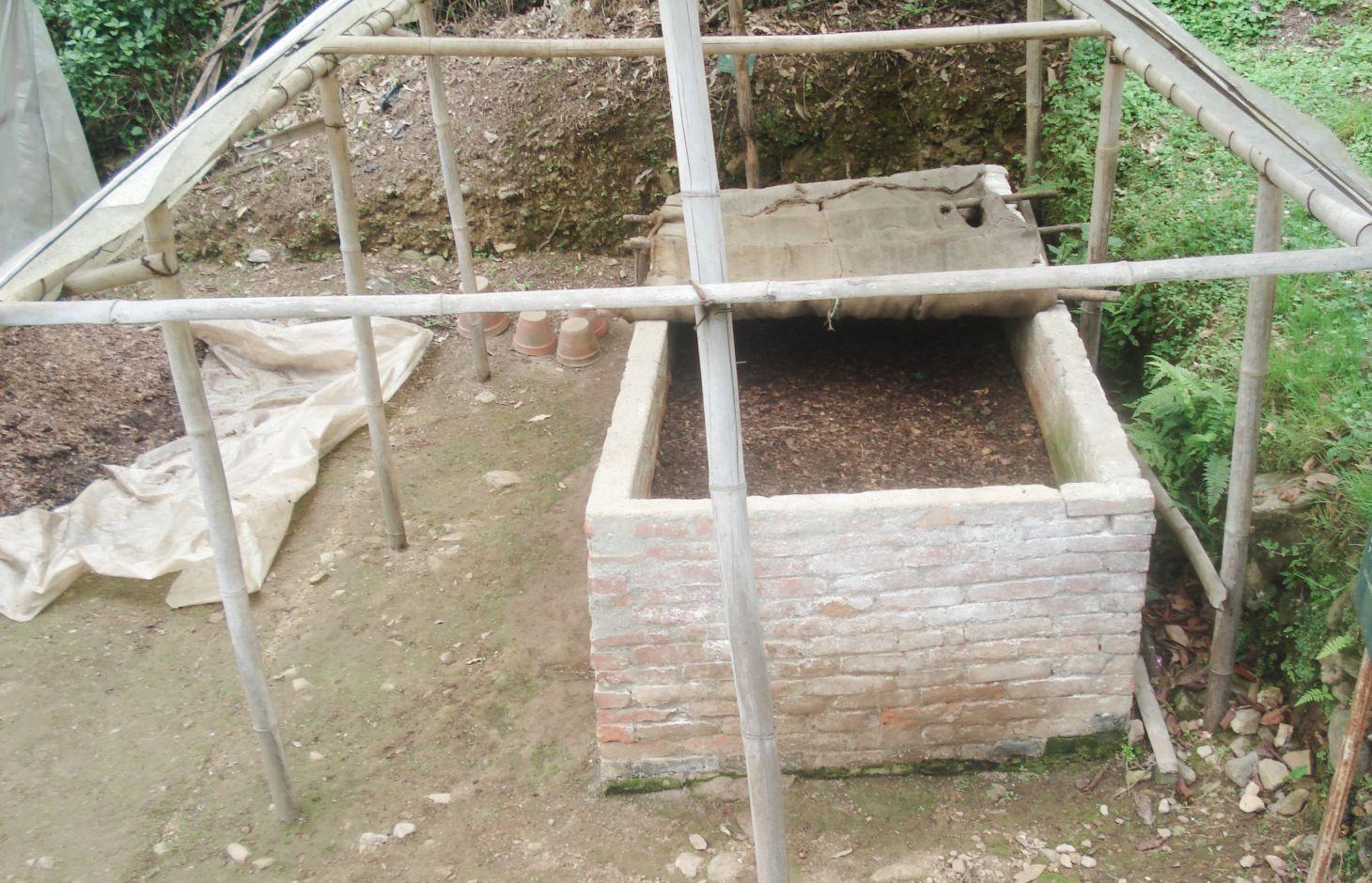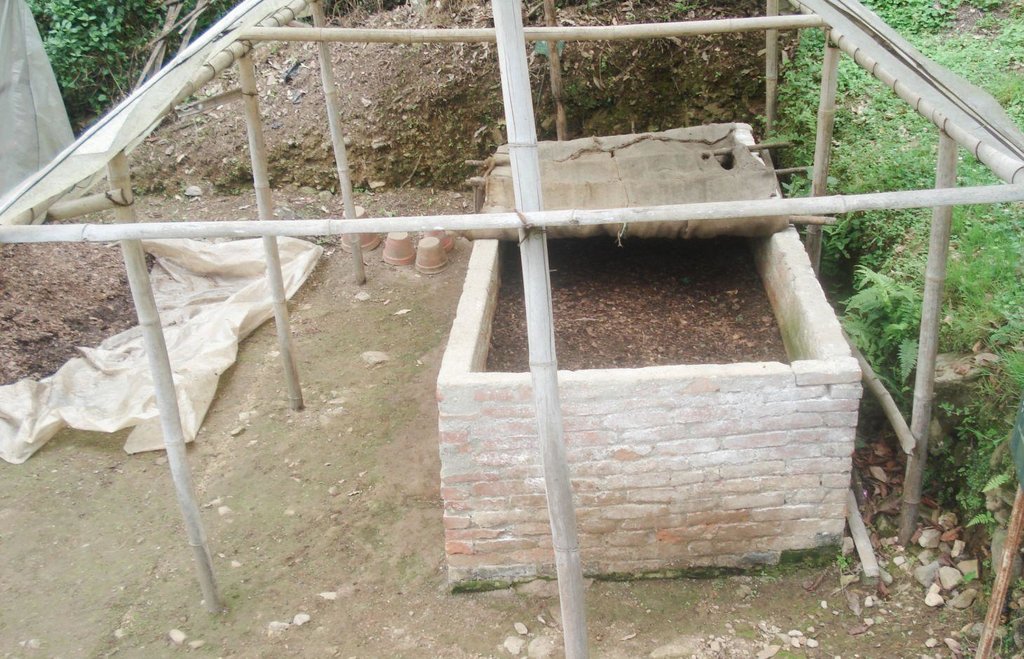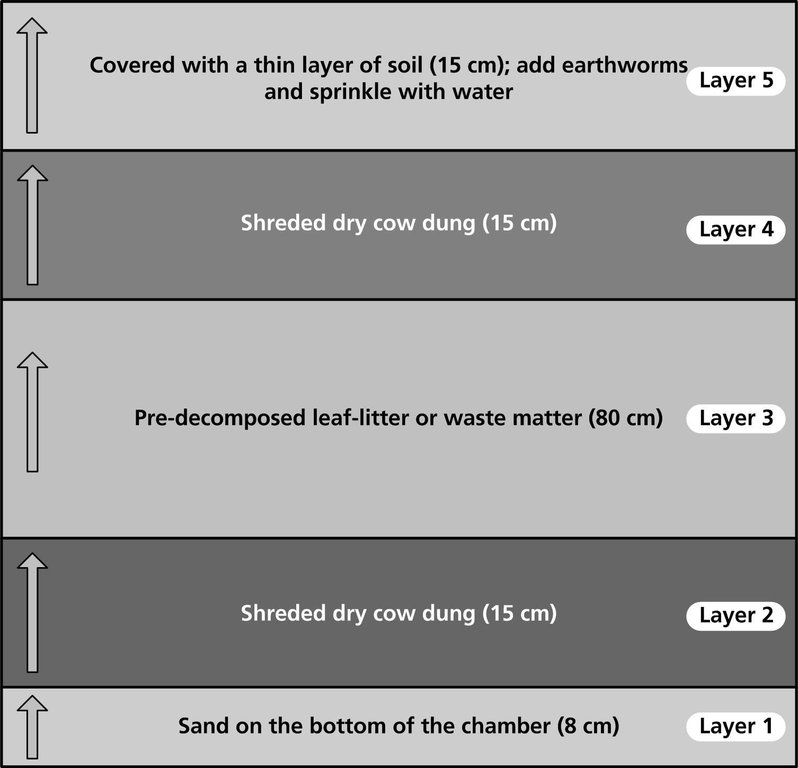Vermicomposting [النيبال]
- تاريخ الإنشاء:
- تحديث:
- جامع المعلومات: Shreedip Sigdel
- المحرر: –
- المُراجع: David Streiff
Gadaula proyog gari mal banaune prabidhi (Main Contributor: Samden Sherpa, ICIMOD)
technologies_1695 - النيبال
عرض الأقسام
توسيع الكل طي الكل1. معلومات عامة
1.2 تفاصيل الاتصال بالأشخاص الرئيسيين لمصدر المعلومات والمؤسسات المشاركة في تقييم وتوثيق التقنية
متخصص في الإدارة المستدامة للأراضي:
Sherpa Samden Lama
+977 1 5003222
ssherpa@icimod.org
ICIMOD
P.O.Box 3226, Kathmandu, Nepal
النيبال
اسم المؤسسة (المؤسسات) التي سهلت توثيق/تقييم التقنية (إذا كان ذلك على صلة)
ICIMOD International Centre for Integrated Mountain Development (ICIMOD) - النيبال1.3 الشروط المتعلقة باستخدام البيانات الموثقة من خلال WOCAT
متى تم تجميع البيانات (ميدانيا)؟:
01/03/2013
يوافق جامع المعلومات والشخص (لاشخاص) الرئيسي لمصدر المعلومات على الشروط المتعلقة باستخدام البيانات الموثقة من خلال WOCAT:
نعم
2. وصف تقنيةالإدارة المستدامي للأراضي
2.1 وصف مختصر للتقنية
تعريف التقنية:
Vermicomposting or worm composting is a simple technology for converting biodegradable waste into organic manure with the help of earthworms.
2.2 وصف تفصيلي للتقنية
الوصف:
Earthworms are valued by farmers because, in addition to aerating the soil, they digest organic matter and produce castings that are a valuable source of humus. Vermicomposting, or worm composting is a simple technology that takes advantage of this to convert biodegradable waste into organic manure with the help of earthworms (the red worm Eisenia foetida) with no pile turning, no smell, and fast production of compost. The earthworms are bred in a mix of cow dung, soil, and agricultural residues or predecomposed leaf-litter. The whole mass is converted into casts or vermicompost, which can be used as a fertilizer on all types of plants in vegetable beds, landscaping areas, or lawns.
Purpose of the Technology: Worms are so effective at processing organic waste that they can digest almost half their own weight in debris every day. Vermicomposting is a simple composting process that takes advantage of what earthworms do naturally, but confines the worms to bins making it easier for farmers to feed them and to harvest their nutrient-rich compost. Since all worms digest organic matter, in principle, any type of worm can be used; however, not all are equally well adapted to living in bins since some worms prefer to live deep in the soil while others are better adapted to living closer to the surface. The red worm (Eisenia foetida) is ideal for vermicomposting because its natural habitat is close to the surface and it is accustomed to a diet rich in organic matter, this makes it ideally suited to digesting kitchen scraps and to living in bins.
Establishment / maintenance activities and inputs: Vermicomposting can be carried out in different types of containers. There are only a few requirements for a good worm pit, the most important being good ventilation; the pit needs to have more surface area than depth (wide and shallow) and it needs to have relatively low sides. The base of the worm pit is prepared with a layer of sand then alternating layers of shredded dry cow dung and degradable dry biomass and soil are added. Under ideal conditions, 1,000 earthworms can covert 45 kg of wet biomass per week into about 25 kg of vermicompost.
Natural / human environment: Worm castings contain five times more nitrogen, seven times more phosphorous, and eleven times more potassium than ordinary soil, the main minerals needed for plant growth. The vermicompost is so rich in nutrients that it should be mixed 1:4 with soil for plants to be grown in pots and containers. Vermicompost should not be allowed to dry out before using.
Note: This type of vermicomposting is sometimes referred to as 'Pusa' vermicomposting because it was popularized in South Asia by the Rajendra Agricultural University located in Pusa, Bihar, India.
2.3 صور التقنية
2.5 البلد/المنطقة/المواقع التي تم تنفيذ التقنية فيها والتي يغطيها هذا التقييم
البلد:
النيبال
مزيد من التفاصيل حول الموقع:
Godavari, Lalitpur District
2.7 إدخال التقنية
حدد كيف تم إدخال التقنية:
- أثناء التجارب/الأبحاث
- من خلال المشاريع/ التدخلات الخارجية
3. تصنيف تقنية الإدارة المستدامي للأراضي
3.1 الغرض الرئيسي ( الأغراض الرئيسية) للتقنية
- Improve fertilizer
3.2 نوع (أنواع) استخدام الأراضي الحالية حيث يتم تطبيق التقنية

الأراضي الزراعية
- زراعة سنوية
- زراعة معمرة (غير خشبية)
التعليقات:
Major land use problems (compiler’s opinion): Crop productivity is limited by poor soil fertility, intense cropping, and a scarcity of irrigation water. Farmers notice a marked decrease in the health of their crops and degraded soil conditions when chemical fertilizers are overused. Vermicomposting is a low input response to this problem.
Forest products and services: fuelwood
Other forest products and services: fodder
3.4 مجموعةالإدارة المستدامة للأراضي التي تنتمي إليها هذه التقنية
- الإدارة المتكاملة لخصوبة التربة
- إدارة النفايات / إدارة مياه الصرف الصحي
3.5 انتشار التقنية
حدد انتشار التقنية:
- يتم تطبيقها في نقاط محددة/ تتركز على مساحة صغيرة
3.6 التدابير التقنية في مجال إلادارة المستدامة للأراضي

التدابير الزراعية
- A2: المادة العضوية/خصوبة التربة
3.7 الأنواع الرئيسية من تدهور الأراضي التي تناولتها التقنية

التدهور الكيميائي للتربة
- (Cn): تراجع الخصوبة وانخفاض محتوى المادة العضوية (غير ناتج عن الانجراف)
التعليقات:
Main causes of degradation: soil management
3.8 منع أو حد أو عكس تدهور الأراضي
تحديد هدف التقنية فيما يتعلق بتدهور الأراضي:
- منع تدهور الأراضي
4. المواصفات الفنية، وأنشطة التنفيذ، والمدخلات، والتكاليف
4.1 الرسم الفني للتقنية
4.2 المواصفات الفنية/شروحات الرسم الفني
Establishing a vermicompost pit
Diagram showing the layers needed to set up a vermicompost pit. Note that the middle layer is the thickest; the worms start here and eat both upwards and downwards. It is best to house the pit under a thatched or plastic roof in order to shield it from excessive sunshine and rain.
Technical knowledge required for field staff / advisors: moderate
Technical knowledge required for land users: moderate
Main technical functions: increase in nutrient availability (supply, recycling,…), Improve Soil Fertility
Secondary technical functions: improvement of topsoil structure (compaction), Stabilizes that soil
4.3 معلومات عامة بخصوص حساب المدخلات والتكاليف
حدد كيفية احتساب التكاليف والمدخلات:
- لكل وحدة تقنية
حدد الوحدة:
worm pit
حدد الحجم والطول وما إلى ذلك (إذا كانت ذات صلة):
A typical outdoor pit can measure 4 m long, 1 m wide and 0.75 m high
حدد العملة المستخدمة لحساب التكاليف:
- دولار أمريكي
4.4 أنشطة التأسيس
| النشاط | نوع التدبير | التوقيت | |
|---|---|---|---|
| 1. | A low cost pit can be constructed with bricks on a moist or shaded site | ||
| 2. | If bricks are not available, stones can be used for the pit construction; | ||
| 3. | alternatively, a wooden or bamboo box or a plastic tray can also be used. | ||
| 4. | Vermicompost pits are best started during the summer months. | ||
| 5. | A thatched roof was built over the pit to help retain moisture in the heap | ||
| 6. | at a level of approximately 40–50%, as well as to maintain an optimal temperature of about 20–30oC. | ||
| 7. | Sand, soil, cow dung, and leaf litter are piled up as shown in the diagram. | ||
| 8. | Material Used are Bricks and cement, dry cow dung, plastic sheet/bamboo, earthworm (around 2000) |
4.5 التكاليف والمدخلات اللازمة للتأسيس
| تحديد المدخلات | الوحدة | الكمية | التكاليف لكل وحدة | إجمالي التكاليف لكل مدخل | % من التكاليف التي يتحملها مستخدمو الأراضي | |
|---|---|---|---|---|---|---|
| العمالة | Construction of pit | persons/day/unit | 10,0 | 5,0 | 50,0 | |
| مواد البناء | Brick and cement | unit | 1,0 | 70,0 | 70,0 | |
| مواد البناء | Dry cow dung | unit | 1,0 | 10,0 | 10,0 | |
| مواد البناء | Plastic sheet/bamboo | unit | 1,0 | 70,0 | 70,0 | |
| مواد البناء | Earthworm (2000) | unit | 1,0 | 60,0 | 60,0 | |
| إجمالي تكاليف إنشاء التقنية | 260,0 | |||||
التعليقات:
Duration of establishment phase: 3 month(s)
4.6 الصيانة/الأنشطة المتكررة
| النشاط | نوع التدبير | التوقيت/الوتيرة | |
|---|---|---|---|
| 1. | Water regularly and collect, harvest vermicompost | زراعية | |
| 2. | The pit is watered regularly. After five to six weeks, the top layer is removed and piled in one corner of the pit. After a few days, the worms will have borrowed down to the bottom of this pile and the compost can be harvested. The compost prepared in the pit should be harvested within 6 months and the pit refurbished as for the first set as discussed above. | زراعية |
4.7 التكاليف والمدخلات اللازمة للصيانة/للأنشطة المتكررة (سنويًا)
| تحديد المدخلات | الوحدة | الكمية | التكاليف لكل وحدة | إجمالي التكاليف لكل مدخل | % من التكاليف التي يتحملها مستخدمو الأراضي | |
|---|---|---|---|---|---|---|
| العمالة | Watering pit | persons/day/unit | 5,0 | 5,0 | 25,0 | |
| مواد البناء | Dry cow dung | unit | 1,0 | 5,0 | 5,0 | |
| مواد البناء | Water pipe | unit | 1,0 | 10,0 | 10,0 | |
| إجمالي تكاليف صيانة التقنية | 40,0 | |||||
4.8 أهم العوامل المؤثرة على التكاليف
قدم وصفا لأهم العوامل التي تؤثر على التكاليف:
All costs and amounts are rough estimates by the technicians and authors. This was a demonstration project conducted by ICIMOD.
5. البيئة الطبيعية والبشرية
5.1 المناخ
هطول الأمطار السنوي
- < 250 مم
- 251- 500 ملم
- 501 - 750ملم
- 1,000-751 ملم
- 1,500-1,100 ملم
- 2,000-1,500 ملم
- 3,000-2,001 ملم
- 4,000-3,100 ملم
- > 4000 ملم
المنطقة المناخية الزراعية
- شبه رطبة
Thermal climate class: temperate
5.2 طوبوغرافيا
متوسط الانحدارات:
- مسطح (0-2%)
- بسيط (3-5%)
- معتدل (6-10%)
- متدحرج (11-15%)
- تلال (16-30%)
- شديدة الانحدار(31-60%)
- فائقة الانحدار (>60%)
التضاريس:
- هضاب/سهول
- أثلام مرتفعة
- المنحدرات الجبلية
- منحدرات التلال
- منحدرات في السفوح
- قاع الوادي
المنطقة الارتفاعية:
- 100-0 متر فوق سطح البحر
- 500-101 متر فوق سطح البحر
- 1,000-501 متر فوق سطح البحر
- 1,500-1,001 متر فوق سطح البحر
- 2,000-1,501 متر فوق سطح البحر
- 2,500-2,100 متر فوق سطح البحر
- 3,000-2,501 متر فوق سطح البحر
- 4,000-3,001 متر فوق سطح البحر
- > 4000 متر فوق سطح البحر
5.3 التربة
متوسط عمق التربة:
- ضحل جدًا (0-20 سم)
- ضحلة (21-50 سم)
- متوسطة العمق (51-80 سم)
- عميقة (81-120 سم)
- عميقة جدًا (> 120 سم)
قوام التربة (التربة السطحية):
- متوسط ( طميي، سلتي)
المواد العضوية في التربة السطحية:
- عالية (>3%)
إذا كان متاحًا، قم بإرفاق وصف كامل للتربة أو تحديد المعلومات المتوفرة، على سبيل المثال نوع التربة، الرقم الهيدروجيني/ درجة حموضة التربة، قدرة التبادل الكاتيوني، النيتروجين، الملوحة وما إلى ذلك.
Soil fertility is medium
Soil drainage / infiltration is medium
Soil water storage capacity is medium
5.4 توافر المياه ونوعيتها
منسوب المياه الجوفية:
< 5 م
توافر المياه السطحية:
جيد
نوعية المياه (غير المعالجة):
مياه شرب جيدة
تعليقات ومواصفات أخرى بشأن نوعية المياه وكميتها:
Water quality (untreated): Also for agricultural use (irrigation)
5.5 التنوع البيولوجي
تنوع الأنواع:
- مرتفع
التعليقات والمواصفات الإضافية بشأن التنوع البيولوجي:
695 species of flora and 230 species of fauna have been documented within the Park's 30 ha area
5.6 خصائص مستخدمي الأراضي الذين يطبقون التقنية
التوجه السوقي لنظام الإنتاج:
- مختلط (كفاف/ تجاري)
الدخل من خارج المزرعة:
- >50% من إجمالي الدخل
المستوى النسبي للثروة:
- ضعيف
مستوى المكننة:
- عمل يدوي
- الجر الحيواني
اذكر الخصائص الأخرى ذات الصلة لمستخدمي الأراضي:
Population density: < 10 persons/km2
5.7 متوسط مساحة الأرض المملوكة أو المستأجرة من قبل مستخدمي الأراضي الذين يطبقون التقنية
- < 0.5 هكتارا
- 0.5 - 1 هكتار
- 1 -2 هكتار
- 2 - 5 هكتار
- 5 - 15 هكتار
- 15 - 50 هكتار
- 50 - 100هكتار
- 500-100 هكتار
- 1,000-500 هكتار
- 10,000-1,000 هكتار
- > 10,000 هكتار
5.8 ملكية الأراضي، وحقوق استخدام الأراضي، وحقوق استخدام المياه
- Governement
- ICIMOD
- ICIMOD
5.9 الوصول إلى الخدمات والبنية التحتية
الطرق والنقل:
- ضعيف
- معتدل
- جيد
labour:
- ضعيف
- معتدل
- جيد
6. الآثار والتصريحات الختامية
6.1 الآثار التي أظهرتها التقنية في الموقع
الآثار الاجتماعية والاقتصادية
الدخل والتكاليف
النفقات على المدخلات الزراعية
عبء العمل
التعليقات/ حدد:
The vermicompost pit needs to be watered and maintained regularly
آثار اجتماعية واقتصادية أخرى
Earthworms need to be purchased from outside
الآثار الاجتماعية والثقافية
livelihood and human well-being
التعليقات/ حدد:
Provides employment opportunities. Quality compost helps to improve the soil and increases crop production
الآثار الايكولوجية
الآثار الايكولوجية الأخرى
soil fertility
can be used to produce organic crops
use of chemical fertilizer
6.2 الآثار التي أظهرتها التقنية خارج الموقع
dependency on external inputs
6.3 تعرض التقنية وحساسيتها لتغير المناخ التدريجي والظواهر المتطرفة/الكوارث المرتبطة بالمناخ (كما يراها مستخدمو الأراضي)
العواقب الأخرى المتعلقة بالمناخ
العواقب الأخرى المتعلقة بالمناخ
| كيف تتعامل التقنية مع ذلك؟ | |
|---|---|
| active in warm climate | جيدا |
6.4 تحليل التكلفة والعائد
كيف يمكن مقارنة العوائد نسبة لتكاليف الإنشاء (من وجهة نظر مستخدمي الأراضي)؟
عوائد قصيرة الأجل:
إيجابي
عوائد طويلة الأجل:
إيجابي
كيف تتم مقارنة العوائدمع كلفة الصيانة/التكاليف المتكررة (من وجهة نظر مستخدمي الأراضي)؟
عوائد قصيرة الأجل:
إيجابي
عوائد طويلة الأجل:
إيجابي
6.5 اعتماد التقنية
التعليقات:
There is a strong trend towards spontaneous adoption of the Technology
Comments on adoption trend: Vermicomposting training was provided to farmers in Nuwakot, Rasuwa, Godavari, and Bishankhunarayan VDCs by ICIMOD staff in collaboration with local NGOs. More than 60% of the farmers who received training adopted vermicomposting on their own farms and they have also started selling worms to other farmers. The technology has been adopted by others who have visited the ICIMOD Knowledge Park at Godavari but most of these are just interested in introducing it on a small scale, such as, to produce vermicompost from kitchen waste for household use in their own gardens. The participants were also taught how to collect local earthworms to use for composting.
Drivers of adaptation of the technology
• A simple technology and easy to implement
• Local earthworms can be used.
• Not expensive; farmers can construct pits or uses wooden boxes or plastic trays.
• Produces high quality compost with a high concentration of nutrients
• Helps to reduce pests in the soil
• Can be scaled up to produce compost commercially
6.7 نقاط القوة / المزايا / الفرص التي توفرها التقنية
| نقاط القوة/ المزايا/ الفرص من وجهة نظر جامع المعلومات أو غيره من الاشخاص الرئيسيين لمصدر المعلومات |
|---|
|
The use of vermicompost reduces the need for chemical fertilizers and reduces dependence on outside sources. How can they be sustained / enhanced? Promote the technology by disseminating it to a large number of farmers on both small and big farms |
|
Vermicomposting does not require keeping livestock. How can they be sustained / enhanced? It is considered to be a low-cost alternative that uses local earthworms and materials to produce compost. |
| On-farm composting saves the transportation cost needed to deliver compost to the farm. |
6.8 نقاط ضعف / مساوىء / مخاطر التقنية وسبل التغلب عليها
| نقاط الضعف/ المساوىء/ المخاطر من وجهة نظر جامع المعلومات أو غيره من الاشخاص الرئيسيين لمصدر المعلومات | كيف يمكن التغلب عليها؟ |
|---|---|
| Purchasing earthworms from outside may be expensive for farmers. | Farmers can be encouraged to harvest local earthworms for composting. |
| Making compost from earthworms is not very popular in rural areas. | Create greater awareness on how earthworms can be used to compost leaf-litter and other kitchen waste. |
7. المراجع والروابط
7.3 روابط للمعلومات ذات الصلة المتوفرة على الإنترنت
العنوان/الوصف:
Vermicomposting: Journey to forever organic garden (no date)
عنوان الرابط URL:
http://journeytoforever.org/compost_worm.html
الروابط والوحدات المواضيعية
توسيع الكل طي الكلالروابط
لا يوجد روابط
الوحدات المواضيعية
لا يوجد وحدات مواضيعية





